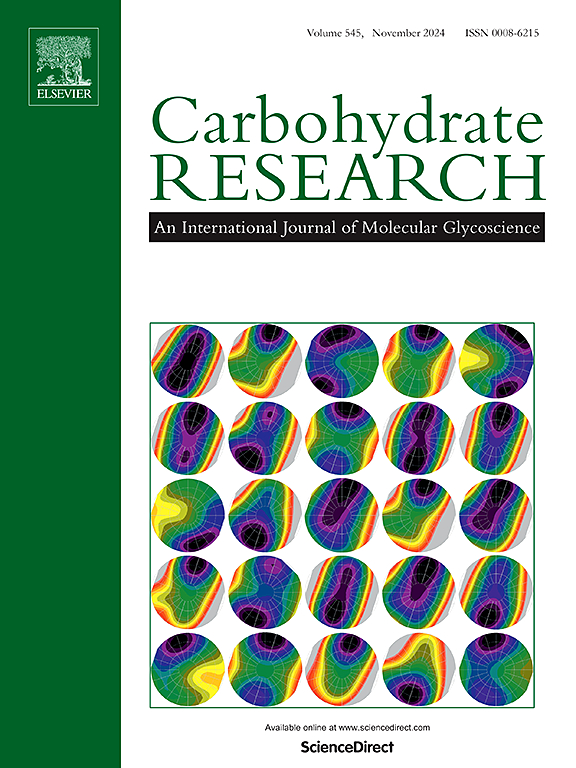水藻中糖基神经酰胺的鉴定和结构表征:来自TLC和NMR技术的见解。
IF 2.4
3区 化学
Q3 BIOCHEMISTRY & MOLECULAR BIOLOGY
引用次数: 0
摘要
海参因其药用特性被广泛用于东方菜肴中。抗氧化、抗真菌、抗病毒、抗癌和神经保护活性已经在一些物种和不同的组织中被发现。在一类具有生物活性的化合物中,脑苷类化合物对细胞,特别是神经细胞的正常功能具有重要作用。这类化合物的鉴定可以使用简单的技术,如薄层色谱(TLC)或更复杂的技术,如核磁共振(NMR),根据所使用的技术提供不同的信息。因此,本研究旨在确定脑苷在水蚤不同组织中的存在。薄层色谱分析和硅胶柱分离,可以准确地识别脑苷阳性组分。这种选择性对于确保所鉴定的化合物是真正的脑苷至关重要,消除了其他不相关谱带的干扰。核磁共振波谱分析证实了葡萄糖神经酰胺在研究组织中的存在。与神经酰胺连接的β-葡萄糖的鉴定,具有特定的结构特征,如鞘氨醇的3‘碳上的羟基和4’和5'碳之间的双键,突出了使用所使用技术获得的结构测定的准确性。本文章由计算机程序翻译,如有差异,请以英文原文为准。

Identification and structural characterization of glucosylceramides in Holothuria (Halodeima) grisea: Insights from TLC and NMR techniques
Sea cucumbers are widely used in oriental cuisine due to their medicinal properties. Antioxidant, antifungal, antiviral, anticancer and neuroprotective activities have already been identified in several species and in different tissues. Among the class of compounds with biological activity are cerebrosides, which have important functions for the proper functioning of cells, especially neuronal cells. The identification of this class of compounds can be carried out using simple techniques such as thin layer chromatography (TLC) or more sophisticated techniques such as nuclear magnetic resonance (NMR), providing different information depending on the technique used. Therefore, this work aimed to identify the presence of cerebrosides in different tissues of Holothuria (Halodeima) grisea. TLC analysis and separation on a silica column made it possible to accurately identify the positive fractions for cerebrosides. This selectivity is crucial to ensure that the compounds identified are genuine cerebrosides, eliminating interference from other non-pertinent bands. NMR spectroscopy analyses confirmed the presence of glucosylceramide in the tissues studied. The identification of a β-glucose linked to the ceramide, with specific structural characteristics such as hydroxyl on the 3′ carbon of the sphingosine and a double bond between the 4′ and 5′ carbons, highlights the accuracy of the structural determination obtained with the techniques used.
求助全文
通过发布文献求助,成功后即可免费获取论文全文。
去求助
来源期刊

Carbohydrate Research
化学-生化与分子生物学
CiteScore
5.00
自引率
3.20%
发文量
183
审稿时长
3.6 weeks
期刊介绍:
Carbohydrate Research publishes reports of original research in the following areas of carbohydrate science: action of enzymes, analytical chemistry, biochemistry (biosynthesis, degradation, structural and functional biochemistry, conformation, molecular recognition, enzyme mechanisms, carbohydrate-processing enzymes, including glycosidases and glycosyltransferases), chemical synthesis, isolation of natural products, physicochemical studies, reactions and their mechanisms, the study of structures and stereochemistry, and technological aspects.
Papers on polysaccharides should have a "molecular" component; that is a paper on new or modified polysaccharides should include structural information and characterization in addition to the usual studies of rheological properties and the like. A paper on a new, naturally occurring polysaccharide should include structural information, defining monosaccharide components and linkage sequence.
Papers devoted wholly or partly to X-ray crystallographic studies, or to computational aspects (molecular mechanics or molecular orbital calculations, simulations via molecular dynamics), will be considered if they meet certain criteria. For computational papers the requirements are that the methods used be specified in sufficient detail to permit replication of the results, and that the conclusions be shown to have relevance to experimental observations - the authors'' own data or data from the literature. Specific directions for the presentation of X-ray data are given below under Results and "discussion".
 求助内容:
求助内容: 应助结果提醒方式:
应助结果提醒方式:


